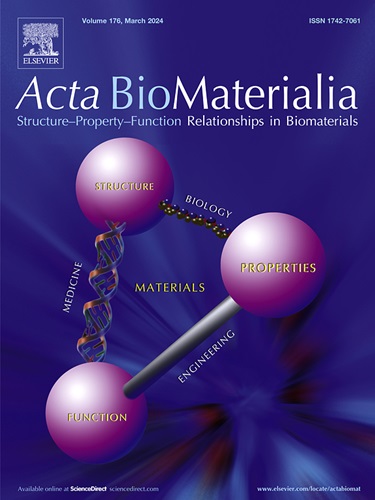TLR2和TLR4的共同抑制降低了对生物材料植入物的异物反应。
IF 9.4
1区 医学
Q1 ENGINEERING, BIOMEDICAL
引用次数: 0
摘要
异物反应(FBR)是发生在任何非生物植入式生物材料上的一种可怕的反应,并导致纤维包封。非特异性蛋白质吸附是FBR的第一阶段,被认为是通过激活先天免疫细胞来启动应答。在这里,我们发现toll样受体(TLRs) 2和4是主要的受体,负责识别表面吸附蛋白作为损伤相关分子模式(DAMPs),并决定材料依赖性FBR。使用多种生物材料的体外模型发现,巨噬细胞(而非中性粒细胞)通过TLR2和/或TLR4对表面吸附的血浆产生反应,并且需要删除两者才能抑制所有材料的激活。在更复杂的体内环境中,同时缺失TLR2和TLR4几乎消除了对多种生物材料的FBR,消除了皮下植入小鼠模型中的物质依赖性。根据材料的不同,TLR2或TLR4的缺失要么没有影响,要么部分减少,这表明tlr决定了体内材料依赖性FBR。总的来说,我们发现TLR2和TLR4是FBR的必要受体,并暗示巨噬细胞对表面吸附蛋白的DAMPs的识别,这取决于材料,是启动FBR的主要驱动因素。我们的研究结果确立了TLR2和TLR4作为治疗靶点,可以在一系列植入式材料中逃避FBR。意义声明:人工合成生物材料植入后会引起异物反应(FBR),导致纤维包封。然而,其机制尚不完全清楚。当植入生物材料时,蛋白质非特异性地吸附在材料上。这些蛋白可能作为受损的相关分子模式(DAMPs)诱导炎症。Toll样受体(TLR) 2和4是已知的识别DAMPs的受体。本研究研究了几种不同的生物材料,发现TLR2和TLR4以材料依赖的方式介导FBR。删除TLR2和TLR4是抑制所有材料纤维囊形成的必要条件。我们的研究结果提供了直接证据,证明DAMPs是FBR的主要驱动因素,并建立了TLR2/4作为逃避FBR的潜在治疗靶点。本文章由计算机程序翻译,如有差异,请以英文原文为准。

The foreign body response to biomaterial implants is reduced by co-inhibition of TLR2 and TLR4
The foreign body response (FBR) is a formidable reaction that occurs to any non-biological implantable biomaterial and results in fibrous encapsulation. Non-specific protein adsorption is the first stage of the FBR and is thought to initiate the response by activation of innate immune cells. Here we show that Toll-like receptors (TLRs) 2 and 4 are the primary receptors responsible for recognizing surface adsorbed proteins as damage associated molecular patterns (DAMPs) and they determine the material dependent FBR. An in vitro model using multiple biomaterials identified that macrophages, not neutrophils, respond to surface-adsorbed plasma via TLR2 and/or TLR4 and that deletion of both was required to inhibit activation across all materials. In the more complex in vivo environment, simultaneous deletion of TLR2 and TLR4 nearly abrogated the FBR to multiple biomaterials and eliminated the material dependencies in a subcutaneous implant mouse model. Deletion of either TLR2 or TLR4 showed either no effect or a partial reduction, depending on the material, demonstrating that TLRs determine the material-dependent FBR in vivo. Collectively, we identified TLR2 and TLR4 as necessary receptors for the FBR and implicate macrophage recognition of DAMPs of surface-adsorbed proteins, which vary depending on the material, as the main driver initiating the FBR. Our findings establish TLR2 and TLR4 as therapeutic targets to evade the FBR across a range of implantable materials.
Statement of significance
Synthetic biomaterials when implanted elicit a foreign body response (FBR) leading to fibrous encapsulation. The mechanisms however are not fully understood. When a biomaterial is implanted, proteins non-specifically adsorb to the material. These proteins may act as damaged associated molecular patterns (DAMPs) to induce inflammation. Toll like receptor (TLR) 2 and 4 are known receptors that recognize DAMPs. This work investigated several different biomaterials and found that TLR2 and TLR4 mediate the FBR in a material-dependent manner. Deleting both TLR2 and TLR4 was necessary to inhibit significantly fibrous capsule formation across all materials tested. Our findings provide direct evidence that DAMPs are the main driver of the FBR and establish TLR2/4 as potential therapeutic targets to evade the FBR.
求助全文
通过发布文献求助,成功后即可免费获取论文全文。
去求助
来源期刊

Acta Biomaterialia
工程技术-材料科学:生物材料
CiteScore
16.80
自引率
3.10%
发文量
776
审稿时长
30 days
期刊介绍:
Acta Biomaterialia is a monthly peer-reviewed scientific journal published by Elsevier. The journal was established in January 2005. The editor-in-chief is W.R. Wagner (University of Pittsburgh). The journal covers research in biomaterials science, including the interrelationship of biomaterial structure and function from macroscale to nanoscale. Topical coverage includes biomedical and biocompatible materials.
 求助内容:
求助内容: 应助结果提醒方式:
应助结果提醒方式:


